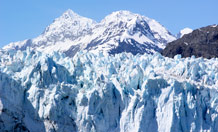
Glaciers are melting faster than they have for at least 350 years.
Glaciers contributing to faster sea-level rise
Melting mountain glaciers are contributing to sea-level rise faster than at any time in the last 350 years, according to new research published in Nature Geoscience.
A research team from the University of Exeter, Aberystwyth University, and Stockholm University undertook a survey of the 270 largest outlet glaciers of the South and North Patagonian Icefields of South America.
Dr Stephan Harrison, from the University of Exeter’s Geography department, said: “The work is significant because it is the first time anyone has made a direct estimate of the sea-level contribution from glaciers since the peak of the Industrial Revolution (c. AD 1750-1850). Our results show that recent (1990-2000) estimates of rates of glacier contribution to sea-level rise are well above the long-term (1650/1750-2010 and 1870-2010) average.”
The team mapped changes in the position of the glaciers since the “Little Ice Age”; the last time that they were much larger in the recent past.
They calculated the volume of ice lost by the glaciers as they have retreated and thinned over the last 350 years and compared these volume losses to rates of change over the last 30 years.
Findings showed the rate at which the glaciers are losing volume over the last 30 years is ten to a hundred times faster than the 350 year long-term average.
The study concludes that in recent years these mountain glaciers have rapidly increased their melt rate and thus their contribution to global sea level.
Lead author of the study, Professor Neil Glasser of Aberystwyth University, said: “Previous estimates of sea-level contribution from mountain glaciers are based on very short timescales. They cover only the last 30 years or so when satellite images can be used to calculate rates of glacier volume change.
“We took a different approach by using a new method that allows us to look at longer timescales. We knew that glaciers in South America were much bigger during the Little Ice Age so we mapped the extent of the glaciers at that time and calculated how much ice has been lost by the retreat and thinning of the glaciers.”
You can see this story covered in the Daily Mail, The Independent, and the New York Times.
Date: 6 April 2011
